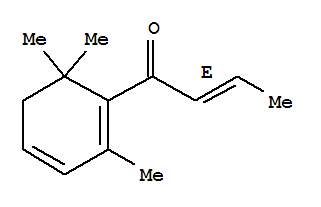| Identification |
| Name: | 2-Buten-1-one,1-(2,6,6-trimethyl-1,3-cyclohexadien-1-yl)-, (2E)- |
| Synonyms: | 2-Buten-1-one,1-(2,6,6-trimethyl-1,3-cyclohexadien-1-yl)-, (E)- (8CI); (E)-Damascenone; (E)-b-Damascenone;2,6,6-Trimethyl-1-trans-crotonoyl-1,3-cyclohexadiene; Damascenone; Damascenone,trans-; trans-2,6,6-Trimethyl-1-(2-butenoyl)cyclohexa-1,3-diene;trans-2,6,6-Trimethyl-1-crotonylcyclohexa-1,3-diene; trans-Damascenone; trans-b-Damascenone; b-Damascenone |
| CAS: | 23726-93-4 |
| EINECS: | 245-844-2 |
| Molecular Formula: | C13H18 O |
| Molecular Weight: | 190.28 |
| InChI: | InChI=1/C13H18O/c1-5-7-11(14)12-10(2)8-6-9-13(12,3)4/h5-8H,9H2,1-4H3/b7-5+ |
| Molecular Structure: |
 |
| Properties |
| Melting Point: | 116-1180C |
| Flash Point: | 111°C |
| Boiling Point: | 275.6°C at 760 mmHg |
| Density: | 0.926g/cm3 |
| Refractive index: | 1.49 |
| Specification: |
Damascenone , its cas register number is 23726-93-4 . It also can be called (E)-1-(2,6,6-Trimethyl-1,3-cyclohexadien-1-yl)-2-buten-1-one . Damascenones are a series of closely related chemical compounds that are components of a variety of essential oils. The damascenones belong to a family of chemicals known as rose ketones, which also includes damascones and ionones. beta-Damascenone is a major contributor to the aroma of roses, despite its very low concentration, and is an important fragrance chemical used in perfumery. The damascenones are derived from the degradation of carotenoids.
|
| Flash Point: | 111°C |
| Usage: | A terpenic ketone; odorant in fruits, vegetables, honey, wine and beer |
| Safety Data |
| |
 |